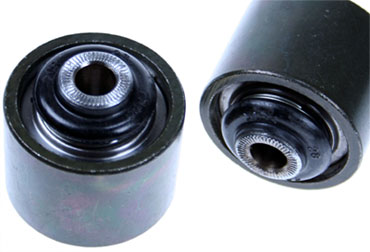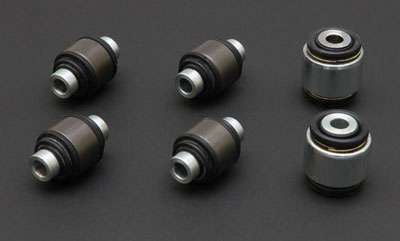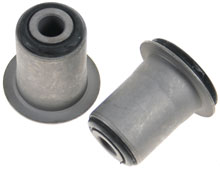Uprated Suspension Mounts

Uprated Replacement Suspension Bushes and Joints
When a manufacturer builds a road going car they have to cater for the lowest common denominator. Part of this process includes ensuring that they won’t receive complaints from mums on a school run or granddads who won’t accept noise and vibration passed through to the cabin. Certain customers expect an extremely high degree of civility from their vehicle. To meet the requirements of these customers and keep manufacturing costs to a minimum manufacturers mount various vehicle components via an insulating rubber bush. Rubber bushes and mounts are used to attach movable and immovable object. Fixed items such as the steering rack are mounted via rubber to minimise vibration being passed into the cabin. Movable items like suspension arms are mounted using a rubber bush to allow the arm to travel through its range of motion by twisting the bush itself but also to insulate the car from noise and vibration.
The problem with the rubber used by manufacturers is that it tends to be overly soft specifically to cater for the school run mums and the like. The soft nature of the bush allows movement of the item outside of its intended route. When you turn the steering wheel on corner entry and start to load up the cars various components with the force caused by cornering you are, as part of that process, compressing the steering rack mounts, the wishbone bushes, the suspension top bushes, anti roll bar drop links, anti roll bar mounting bushes etc. As each of these bushes compresses it alters the effect your steering input has on the course the vehicle takes meaning you need to adjust your steering input to compensate. It also slows down the rate at which your steering input changes the direction of the vehicle reducing steering response and feel.

The compression of these bushes also progressively alters the geometry of the vehicle making the car feel vague and moveable as it approaches its handling limits. Soggy, ponderous and dull are accurate descriptions of many production cars when driven at the limit. Front track control arm bushes, for example, are often a big soft rubber items as standard that allow signification changes in rake (castor ) under cornering, braking an acceleration. Not good for those of us who enjoy a car that does exactly what we tell it to do, not partially make its own decisions dictated by inbuilt geometry changes!
The older the bush the soggier they get so you can image than a relatively soft bush when new is going to allow a significant about of deflection as it ages.
By changing the original soft bushes for uprated items you reduce this movement so reduce geometry change, improve the vehicles response to input, makes the car more predictable and easier to control and ultimately produce a car that is safer to drive faster. Hardrace use an uprated rubber compound rather than polyurethane to minimise noise and vibration transmission. You get the best of both worlds, a car that is still quiet and compliant but that handles better.

Alternatively you can choose to replace the rubber bushes altogether in favour of a bearing. These eliminate any lateral movement completely locating the arm solidly in position to only rotate in its designed sweep of motion. Rubber and polyurethane bushes provide significant resistance to arm movement, they want the arm to sit in the position it was fitted in so when the wheel moves upwards through its travel the bush tries to push the arm back down to its resting position. The rose joints and bearings allow free movement of the arm with minimal stiction. This allows the suspension to work more efficiently improving the spring and dampers ability to function as designed and keep the cars tyres in contact with the ground and control body movement.
Many of the Hardrace joints feature 100% sealed bearing via a moulded rubber section that is integrated into the body of the bearing. This completely protects the bearing internals from the external elements so increases the life of the joint immensely compared to those with no protection or a loose fitting rubber boot.
